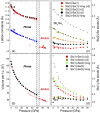Sb₂Se₃ under pressure
- PMID: 24045363
- PMCID: PMC3776230
- DOI: 10.1038/srep02665
Sb₂Se₃ under pressure
Abstract
Selected members of the A₂B₃ (A = Sb, Bi; B = Se, Te) family are topological insulators. The Sb₂Se₃ compound does not exhibit any topological properties at ambient conditions; a recent high-pressure study, however, indicated that pressure transforms Sb₂Se₃ from a band insulator into a topological insulator above ~2 GPa; in addition, three structural transitions were proposed to occur up to 25 GPa. Partly motivated by these results, we have performed x-ray diffraction and Raman spectroscopy investigations on Sb₂Se₃ under pressure up to 65 GPa. We have identified only one reversible structural transition: the initial Pnma structure transforms into a disordered cubic bcc alloy above 51 GPa. On the other hand, our high-pressure Raman study did not reproduce the previous results; we attribute the discrepancies to the effects of the different pressure transmitting media used in the high-pressure experiments. We discuss the structural behavior of Sb₂Se₃ within the A₂B₃ (A = Sb, Bi; B = Se, Te) series.
Figures




References
-
- Ovsyannikov S. V. & Shchennikov V. V. High-Pressure Routes in the Thermoelectricity or How One Can Improve a Performance of Thermoelectrics. Chem. Mater. 22, 635 (2010).
-
- Chen Y. L. et al. Experimental Realization of a Three-Dimensional Topological Insulator, Bi2Te3. Science 325, 178 (2009). - PubMed
-
- Zhang H. J. et al. Topological insulators in Bi2Se3, Bi2Te3 and Sb2Te3 with a single Dirac cone on the surface. Nat. Phys. 5, 438 (2009).
-
- Qi X.-L. & Zhang S.-C. Topological insulators and superconductors. Rev. Mod. Phys. 83, 1057 (2011).
-
- Yan B. & Zhang S.-C. Topological materials. Rep. Prog. Phys. 75, 96501 (2012). - PubMed
Publication types
LinkOut - more resources
Full Text Sources
Other Literature Sources

